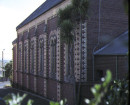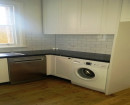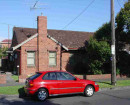HOLLINSHED HOUSE
2 Snowden Place CANTERBURY, BOROONDARA CITY
-
Add to tour
You must log in to do that.
-
Share
-
Shortlist place
You must log in to do that.
- Download report


Statement of Significance
What is Significant?
The residence at 2 Snowden Place, Canterbury is significant. It was designed by the noted Australian theatre architect Charles N. Hollinshed as his own residence.
How is it significant?
2 Snowden Place, Canterbury is of local historical, architectural and aesthetic significance to the City of Boroondara.
Why is it significant?
2 Snowden Place (1951) is of historical significance as it is representative of an established pattern of architects designing homes for themselves in the City of Boroondara. This pattern continues today with John Wardle's own house on Kevin Grove in Kew. (Criterion A)
2 Snowden Place is representative of the post-war design ethos, optimism and architectural modernisation pioneered by Robin Boyd. The design features honesty of structure and material, clean lines, deep eaves and an overall sense of innovation in design characteristic of this period. (Criterion D)
The house is also an important work within Hollinshed's oeuvre as it is both a departure from his usual theatre commissions and the style of his residential work, most of which has now been demolished. The dwelling also demonstrates his easy adoption of innovative and contemporary styles. (Criterion H)
-
-
HOLLINSHED HOUSE - Physical Description 1
Snowden Place is bordered by Mont Albert Road to the north, Victoria Avenue to the east, Canterbury Road to the south and Monomeath Avenue to the west (refer Figure 139).
Completed in 1951, the Hollinshed residence is a two-storey overpainted, expressed brick house with a flat roof with deep eaves. A first-floor addition to the principal elevation of the residence, atop the existing garage, was completed in 1970 and possesses a skillion roof that adopts the same expressed brick construction and eave depth as that of the original house. Other early additions, located at ground floor level, are located at the rear of the house and are obscured from the street. The original entry porch was enclosed in 1977, to a design by Campbell Thorn, in a complementary manner that reproduces the detailing of the original door, which remains within the porch.
The house retains significant period features which adhere to its initial design in the mid-twentieth century and subsequent extension thereafter, including original fenestration with associated timber framed windows, unpainted rubble stone feature walls and a slate 'crazy-paving' patterned driveway. While the corrugated metal sheet-clad tilt door of the garage does not appear in the 1970 architectural drawings of the house, its industrial design and apparent age is conducive to the period in which the house was constructed and extended.
While the overwhelming majority of the house has been overpainted in a consistent shade of white, this colour complements the expressed stone feature walls and slate-paved driveway of the house visible from Snowden Place. As such, the overall effect of the colour scheme contributes to the cohesiveness of the material palette of the house, with the ability for the original design intent of the house to be continually appreciated despite its sympathetic extension.
Within the grounds, a 10-metre tall, mature Pyrus nivalis (Snow Pear) complements views of the property from Snowden Place. Its size and the position of the driveway in relation to it indicates that it was planted relatively shortly after the construction of the house.
Heritage Study and Grading
Boroondara - Municipal-Wide Heritage Gap Study: Vol. 1 Canterbury
Author: Context
Year: 2018
Grading: Local
-
-
-
-
-
CANTERBURY MANSIONS
 Victorian Heritage Register H0869
Victorian Heritage Register H0869 -
RESIDENCE (FORMERLY COLINTON)
 Victorian Heritage Register H1399
Victorian Heritage Register H1399 -
SHRUBLANDS
 Victorian Heritage Register H2037
Victorian Heritage Register H2037
-
"AQUA PROFONDA" SIGN, FITZROY POOL
 Victorian Heritage Register H1687
Victorian Heritage Register H1687 -
'Aqua Profonda' sign wall sign, Fitzroy Swimming Pool
 Yarra City H1687
Yarra City H1687 -
1 Campbell Street
 Yarra City
Yarra City
-
-












